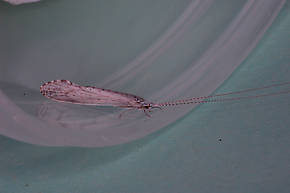Blog & Latest Updates
Fly Fishing Articles
Insects by Common Name


Caddisfly Genus Nectopsyche (White Millers)
Taxonomic Navigation -?-
Kingdom
Animalia (Animals)
» Phylum
Arthropoda (Arthropods)
» Class
Insecta (Insects)
» Order
Trichoptera (Caddisflies)
» Family
Leptoceridae
» Genus Nectopsyche (White Millers)
| Species in Nectopsyche | ||
| Nectopsyche albidaWhite Miller | 0 | 0 |
| Nectopsyche diarinaWhite Miller | 0 | 0 |
| Nectopsyche exquisitaWhite Miller | 0 | 0 |
11 species aren't included.
Common Name
| Match | Common Name |
| White Millers |
Most of the adult activity, both emergence and egg-laying, takes place during the middle of the night. There is some rare overlap with the low-light hours of dusk and dawn, but this genus really belongs to the night fishermen.
Where & When
Regions: East, Midwest, West
Time Of Year (?): Late July to mid-August in the Upper Midwest
Hatching Behavior
Time Of Day (?): Dusk to dawn
Egg-Laying Behavior
Time Of Day: Dusk to nighttime
Larva & Pupa Biology
Current Speed: Slow
Substrate: Vegetation
Pictures of 1 Caddisfly Specimen in the Genus Nectopsyche:
Nectopsyche (White Millers) Caddisfly Adult View 1 PicturesThis is Nectopsyche lahontensis.
View 1 PicturesThis is Nectopsyche lahontensis.
 View 1 PicturesThis is Nectopsyche lahontensis.
View 1 PicturesThis is Nectopsyche lahontensis.Collected September 7, 2005 from the Flathead River-lower in Montana
Added to Troutnut.com by Bnewell on June 30, 2011
Added to Troutnut.com by Bnewell on June 30, 2011
Recent Discussions of Nectopsyche
Moved from genus level to N. albida
Posted by Entoman on Jun 15, 2014 in the species Nectopsyche albida
It is my understanding that wing maculation is quite distinctive and consistent in this genus thus allowing species identification using this character. This specimen has been at the genus level for many years and somehow slipped through the cracks.;)
ReplyWhite Miller Bug 3 Replies »Posted by MIKE54 on May 3, 2013 in the species Nectopsyche albida
Last reply on May 4, 2013 by Adirman
Where did the name "White Miller" come from, for the caddis bug in the warm Yellowstone waters? I am not interested in the east coast mayfly with the same name. Thanks, Mike Miller.
ReplyYour Thoughts On Nectopsyche:
Top 10 Fly Hatches
Top Gift Shop Designs
Eat mayflies.
Top Insect Specimens
Miscellaneous Sites
Troutnut.com is copyright © 2004-2024 Jason
Neuswanger (email Jason). See my FAQ for information about use of my images.
 privacy policy
privacy policy
